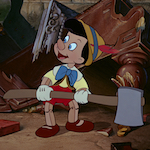 In 1992, Walt Disney Animation was on an undeniable upswing. WHO FRAMED ROGER RABBIT had been a smash in ’88, THE LITTLE MERMAID reignited their musical fairy tale formula in ’89, BEAUTY AND THE BEAST was so respected in ’91 that it got a best picture nomination, and they had ALADDIN coming out in November. It would be funny if they felt the need to re-release classics in the summer to sabotage potential competitors, since ROCK-A-DOODLE and FERNGULLY were long gone by June 26th, 1992 anyway. But I think this was just a reliable money-making technique they had developed, to release an old one in the summer and a new one at the end of the year. Remember that in last year’s summer of ’91 retrospective I got to review the re-release of 101 DALMATIANS, which was really not needed to stave off ROVER DANGERFIELD, in my opinion.
In 1992, Walt Disney Animation was on an undeniable upswing. WHO FRAMED ROGER RABBIT had been a smash in ’88, THE LITTLE MERMAID reignited their musical fairy tale formula in ’89, BEAUTY AND THE BEAST was so respected in ’91 that it got a best picture nomination, and they had ALADDIN coming out in November. It would be funny if they felt the need to re-release classics in the summer to sabotage potential competitors, since ROCK-A-DOODLE and FERNGULLY were long gone by June 26th, 1992 anyway. But I think this was just a reliable money-making technique they had developed, to release an old one in the summer and a new one at the end of the year. Remember that in last year’s summer of ’91 retrospective I got to review the re-release of 101 DALMATIANS, which was really not needed to stave off ROVER DANGERFIELD, in my opinion.
 The “WALT DISNEY’S CLASSIC” for 1992 was the studio’s second-ever animated feature, PINOCCHIO, returning in celebration of its 52nd anniversary, I guess. 1940 was the same year Daisy Duck made her debut in Mr. Duck Steps Out, Bugs Bunny made his in A Wild Hare, Woody Woodpecker made his in Knock Knock, Abbott and Costello made theirs in One Night in the Tropics, and Captain America and Bucky made theirs in comic books. It was the year of Charlie Chaplin’s THE GREAT DICTATOR, the year DUNKIRK happened, the year Winston Churchill became prime minister, the year the first McDonald’s opened, the year nylon stockings came out. Pretty long ago.
The “WALT DISNEY’S CLASSIC” for 1992 was the studio’s second-ever animated feature, PINOCCHIO, returning in celebration of its 52nd anniversary, I guess. 1940 was the same year Daisy Duck made her debut in Mr. Duck Steps Out, Bugs Bunny made his in A Wild Hare, Woody Woodpecker made his in Knock Knock, Abbott and Costello made theirs in One Night in the Tropics, and Captain America and Bucky made theirs in comic books. It was the year of Charlie Chaplin’s THE GREAT DICTATOR, the year DUNKIRK happened, the year Winston Churchill became prime minister, the year the first McDonald’s opened, the year nylon stockings came out. Pretty long ago.
It was also the year James Cromwell, George Romero, H.R. Giger, Tom Brokaw, Smokey Robinson, Peter Fonda, Chuck Norris, Al Jarreau, James Caan, Herbie Hancock, Al Pacino, Giorgio Moroder, Lance Henriksen, Tom Jones, Patrick Stewart, Raquel Welch, Dario Argento, Roy Ayers, Brian De Palma, Pharoah Sanders, and Dionne Warwick were born, so in that sense it doesn’t seem like a different lifetime. Still, I’m a person of my time, and there aren’t very many works of art from 82 years ago that I connect with very deeply. PINOCCHIO is an exception. I have long considered it my favorite Disney movie. On this viewing I tried to figure out why.
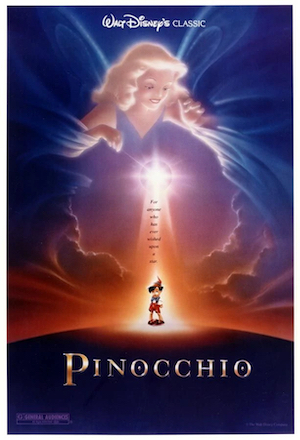
The story structure does not adhere to today’s rules. It strikes me that it’s an 87 minute adventure movie where it takes 27 minutes to even leave the house. Before that we linger in the cluttered home of Austrian woodcarver Geppetto. We know he’s passionate about his artform because so many things in his home are ornately carved: not just the clocks, but the furniture, the mantle, the shelves, the hourglass, the chest, the buckets, the mugs, the jugs, his pipe, the handles of his tools. The feet of the chairs are shaped like faces, his bedposts are toadstools and ravens, even his cat Figaro has a bed decorated with mice and a cat angel. The guy loves to carve.
Since Geppetto wishes upon a star that his favorite wooden marionette Pinocchio could achieve sentience (spirituality was different back then), the Blue Fairy grants his wish and half-jokingly appoints bystander cricket hobo Jiminy to accompany the wooden boy as his conscience. Note that when Geppetto hears this living puppet in the cottage at night he pulls out a musket – luckily he doesn’t shoot the source of the noise, but he does get startled by Figaro jumping up his ass and fires it by mistake. Get rid of that dangerous thing, stupid. (But the animation of his shaky hands and legs is top notch.)
The next day he sends Pinocchio to school. Parents used to do that, and we Gen-Xers did fine even without insect escorts, but Pinocch gets sidetracked by Honest John (an upright fox) and his sidekick Gideon (an upright cat), who sell him to Stromboli to be an “actor” in a puppet show, proving that satirical jabs at sleazy Hollywood existed long before we were born. Related: Jiminy says, “Well, I guess he doesn’t need me anymore. What does an actor want with a conscience, anyway?”
Though this is supposed to be 19th century Italy it seems to me Honest John and Gideon are dressed like Depression era hobos, feigning the upper class status suggested by their top hats and gloves even though they’re torn and full of patches and holes. I’m glad our boy Jiminy also dressed like this until the Blue Fairy gave him new clothes, so those amoral scammers aren’t the only representatives of poverty here.
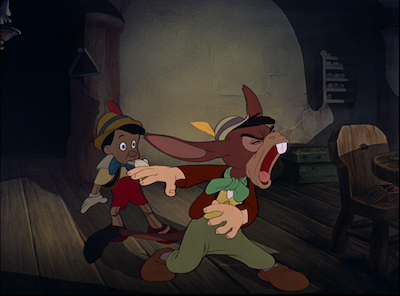
Stromboli leaves Pinocch locked in a cage, and when he gets out the con-animals sell him again, this time to the Coachman, a human trafficker who brings at-risk young men to drink, smoke, gamble and cause destruction for free at the Pleasure Island amusement park – “They say it’s a swell joint. No school, no cops. You can tear the joint apart and nobody says a word” – which magically turns them into jackasses to be sold to salt mines and circuses. Along the way Pinocchio makes a new dickhead friend named Lampwick, who says (and Pinocchio later repeats), “a guy only lives once,” which of course translates to “YOLO” in 2000s speak. Luckily, Pinocchio follows his conscience bug in time to only get the ears and tail of a donkey, but you see he’s not some tee-totaler. He likes to party.
When he gets home he learns that heartbroken Geppetto (with Figaro and their fish Cleo) went looking for him in a boat but got swallowed by a whale named Monstro. So Pinocchio and Jiminy walk on the bottom of the sea, find Monstro, find Geppetto and friends living inside the whale’s belly (there are worse fates), and proves his courage by sacrificing himself to save the old man from drowning. So the fairy resurrects him like Jesus or E.T. and makes him a “real boy.” Like when Casper becomes Devon Sawa.
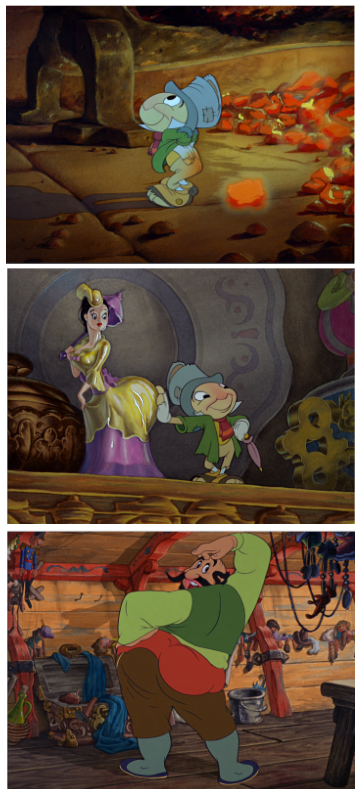 Maybe the end of the plot summary is a weird time to bring this up, but I noticed there’s kind of an emphasis on butts in this movie. I don’t know if that’s for the kids to giggle at or the adults to think is sneakily naughty. But when Jiminy comes in he very specifically warms his ass on a hot coal, and in the narration he says, “As I stood there warming my… myself…” Soon after that he leans on something and realizes his hand is on the ass of a ceramic woman, so he apologizes as if she’s a real person, tips his hat and blushes. And finally there’s a part where Stromboli says “Con-stant-i-no-pl-ey” and does a little dance to I guess represent the dancing ladies of Constantinople and it totally emphasizes his shaking ass cheeks. Edgy stuff.
Maybe the end of the plot summary is a weird time to bring this up, but I noticed there’s kind of an emphasis on butts in this movie. I don’t know if that’s for the kids to giggle at or the adults to think is sneakily naughty. But when Jiminy comes in he very specifically warms his ass on a hot coal, and in the narration he says, “As I stood there warming my… myself…” Soon after that he leans on something and realizes his hand is on the ass of a ceramic woman, so he apologizes as if she’s a real person, tips his hat and blushes. And finally there’s a part where Stromboli says “Con-stant-i-no-pl-ey” and does a little dance to I guess represent the dancing ladies of Constantinople and it totally emphasizes his shaking ass cheeks. Edgy stuff.
Seriously though, it’s amazing to me that I can watch this movie 82 years later and genuinely laugh at some of the jokes. Like when Jiminy sees the puppet given life and remarks, “Whew. What they can’t do these days.” Or when he calls a fish “sister.” Or when they’re scouring the ocean floor for signs of Monstro and all he can think of is to ask a clam, “Uh, pardon me, pearl. Are you acquainted with Monstro the whale?”
But my very favorite exchange is when Stromboli fluffs up Pinocchio about his supposed impending celebrity by saying, “Your face! She will be on the tip of everybody’s tongue!” And Pinocch responds innocently, “Will she?”
Of course they weren’t born yet, but I think of this as a Coen Brothers type joke – the type that’s funny simply from the peculiar language choices of the characters. I don’t have any clue how it played in 1940, but I bet it was always funny that Stromboli chooses to gender Pinocchio’s face and then Pinocchio goes along with it.
An aspect I’ve long been fascinated with is that I love this little cricket and then occasionally remember how few cricket features he actually has. He’s green, he has antennae (though mostly hidden under his hat). But he’s bipedal, he has fingers and even toes, which we wouldn’t think about if not for his socks having holes in them. I guess it’s really just the green skin and the nimble leaping that makes me accept him as a bug. According to a page on waltdisney.org, Walt Disney felt the more cricket-like designs they tried weren’t likable enough. Designer Ward Kimball said of the final product, “It is not a cricket, it is a blob. It is a little man-creature with no ears, and he wears little English outfits, and the only reminiscence of a cricket’s wings are the tails of his coat! The audience accepts him as a cricket because the other characters say he is.”
And I mean, why would the other characters lie?
Maybe one reason this movie is still so beautiful to look at (besides the miracle of high definition remastering) is the fact that it was the second Disney movie (planned as the third, until BAMBI was postponed). They had learned many things from making SNOW WHITE, had proven what could be done, were still hungry to show the potential of the medium, and weren’t yet repeating an existing formula. So it’s just staggering work by incredible artists, with great resources at their hands. The animation is so smooth and the linework is so clean and perfect, with details like what looks like chalk highlights on Figaro’s fur and whiskers, the feather in Pinocchio’s cap, the Blue Fairy’s hair, and Monstro’s skin. The backgrounds are lush and detailed, the effects – such as the Blue Fairy’s magic wand (created by the famous abstract animator Oskar Fischinger) and the realistic water reflections on the ocean floor – are so carefully crafted. The amount of detail in the waves and splashes around Monstro is mind-boggling. And they used the multiplane camera (layers of cels photographed on multiple levels of glass to create depth) for some incredibly complex “camera moves,” as well as some cool, simple ones like the overhead shot with out of focus objects in the foreground.
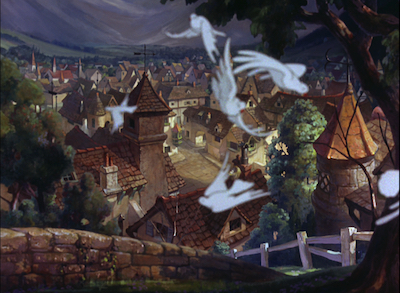

There’s also a cricket’s-hop-POV shot!
In 101 DALMATIANS I was impressed by the three-dimensional car animation created by filming and xeroxing a model with thick lines around its edges, but I don’t remember ever noticing the similar technique here, with the coach painted frame by frame over stop motion shots. It’s just technical achievement after technical achievement.
But all the old Disney movies are technically impressive – why am I so enamored of this one specifically? I think a huge part of its appeal to me is just the world it exists in – the little Italian village with cobblestone roads, cottage packed with gimmicky cuckoo clocks and ornate wood carvings, later the marionette shows and of course the cursed carnival island. Also just that it’s a story about a living wooden puppet and a talking cricket on a journey in a world of humans, but with the occasional upright, clothes-wearing fox and cat duo, or wish-giving fairy. Just a strange place, presented confidently enough to seem perfectly reasonable.
It must be these surface level attachments that do it, because when I try to examine the themes of the thing I don’t find anything great. It’s a moralistic story – go to school, don’t get scammed by phony entertainment people, don’t sit in V.I.P. smoking and drinking and kicking it. I’ve mostly lived that way, but it’s not some deeply held philosophy. I don’t discount the possibility of a Pleasure Island where you get to have fun and not get turned into a donkey. I would support it.
Some interesting interpretations are discussed on the Wikipedia page. There’s a quote from film professor and author Nicholas Sammond arguing that it shows that “the pleasures of the working class, of vaudeville, or of pool halls and amusement parks, led to a life as a beast of burden.” Hmm. A less uncomfortable reading comes from Maurice Sendak, arguing in a superb 1988 essay in the Washington Post that the movie is superior to the book because it makes Pinocchio inherently innocent and only “bad” due to inexperience, rather than being “born bad” and “evil incarnate” as in the book. He also points out that Pinocchio “is loved for himself — and not for what he should or shouldn’t be,” and becomes “a real boy” by growing up (and proving to be “brave, truthful and selfless”), not by pledging obedience to adults.
I like that. I’m convinced. Maybe this is a story about forgiveness. People can fuck up and make a mess of things and not be “bad.” They can still turn their lives around and do good in this world. I’m not talking about our current political divisions, I’m not ready to forgive some of that yet, but there are people who, say, fall into addiction and/or crime or do something stupid and much of society will write them off or look down on them. But they can change, they are people, they are worthy of help and love and forgiveness. That’s a good message.
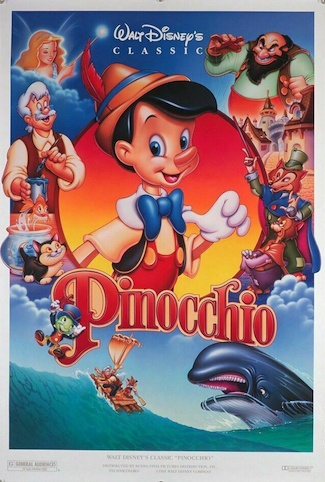 PINOCCHIO foreshadows the 1992 Weird Summer ethos because it’s a studio lavishing enormous resources on an outstanding artistic achievement that seemed at the time like a huge business mistake. It got rave reviews, but it cost twice as much as SNOW WHITE, while making less than it in its initial release – only about half its budget. Of course, then it was re-released in ’45, ’54, ’62, ’71, ’78, ’84 and ’92, not to mention the money it got from television, merchandising, VHS, then DVD, then blu-ray. The 1992 theatrical re-release alone grossed $18.9 million in North America, bringing the movie’s lifetime total to $84.3 million.
PINOCCHIO foreshadows the 1992 Weird Summer ethos because it’s a studio lavishing enormous resources on an outstanding artistic achievement that seemed at the time like a huge business mistake. It got rave reviews, but it cost twice as much as SNOW WHITE, while making less than it in its initial release – only about half its budget. Of course, then it was re-released in ’45, ’54, ’62, ’71, ’78, ’84 and ’92, not to mention the money it got from television, merchandising, VHS, then DVD, then blu-ray. The 1992 theatrical re-release alone grossed $18.9 million in North America, bringing the movie’s lifetime total to $84.3 million.
After Walt Disney’s death, many of the people who worked on these early films tried to continue the tradition as Disney became more of a brand and then an enormous corporation. At times the company has continued to represent a certain type of wide-appeal artistic excellence, but it has also at times been emblematic of our worst ideas of commercialism and corporate monopoly. Right now I think it’s a mix of both, leaning toward the latter. It would be an especially good time for them to look back at the PINOCCHIO era and remember all the good that came from Disney trying to push the artform as far as it could go regardless of the cost or immediate profitability. They would get into mass producing merchandise, but they didn’t treat the films that way. If you’re gonna keep the name you should try to live up to the vision.
In the movie, when Jiminy hears Geppetto make his wish, he says, “A very lovely thought. But not at all practical.” That didn’t matter. He got his wish upon the star anyway, and the song about it is the company’s theme song to this day. They should keep that in mind.
P.S. As is traditional with my reviews of Disney movies, I now present some screen caps I made of scenery I enjoyed.
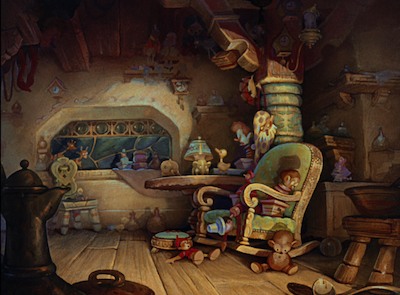
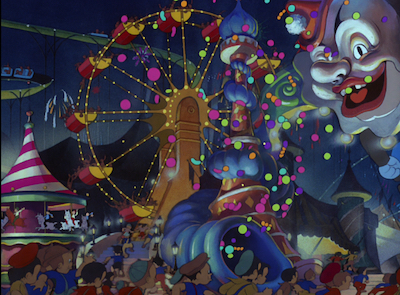
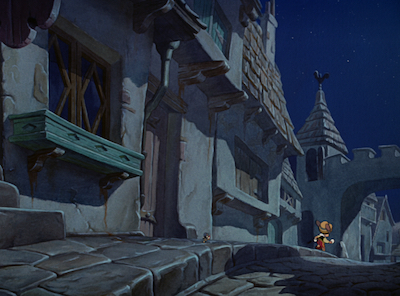
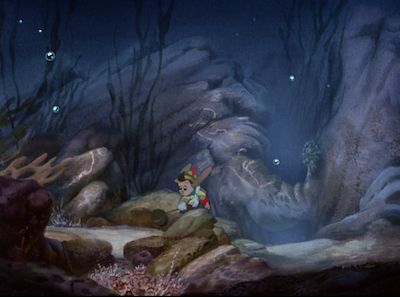
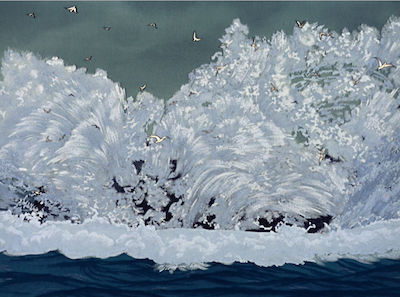
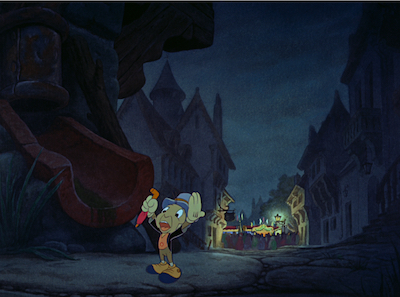
Notes:
Early example of an easter egg: The movie opens on a fancy leatherbound book of Pinocchio on a desk. In the background we can see fancy tomes of Peter Pan and Alice in Wonderland, which of course would later become Disney classics. Surprisingly there’s no Return of Jafar or An Extremely Goofy Book to be seen, but to be fair it’s a 1.37:1 aspect ratio, I’m sure we’d see them there if it was a wider frame.
Some of the characters from PINOCCHIO had further adventures. Jiminy Cricket continued his hosting duties for the 1947 anthology film FUN AND FANCY FREE, as well as a number of TV specials and then educational shorts like I’m No Fool. He also played the Ghost of Christmas Past in the excellent 1983 featurette Mickey’s Christmas Carol.
The 1943 short Figaro and Cleo is a sort of Tom & Jerry deal where Geppetto’s cat tries to eat his fish. More interestingly, Figaro crossed over with Minnie Mouse, Daisy Duck and Pluto in shorts like First Aiders (1944), Bath Day (1946), Figaro and Frankie (1947), Cat Nap Pluto (1948) and Pluto’s Sweater (1949). I guess it makes sense if Honest John and Gideon are walking around in the same world as Pinocchio then Minnie Mouse could be too. But wouldn’t it be weird if Geppetto showed up at Minnie’s house? Like, to do carpentry or something? I just can’t picture it. And how did Figaro become Minnie’s pet anyway? What is going on here?
In the mid-’00s, Disney’s DTV “Disney Toon Studios” developed a PINOCCHIO 2, with a screenplay by Robert Reece (THE LITTLE MERMAID: ARIEL’S BEGINNING). When John Lasseter took over the studio he cancelled it along with DUMBO 2 (which was actually completed!).
In 1999, after the massive success of Julie Taymor’s The Lion King stage musical, she was reported to be in talks with Disney to do the same with PINOCCHIO. They spent a few years developing it but according to Taymor it fell apart because she wanted it to be closer to the Collodi book and Disney wanted it closer to their movie. I was fascinated with it for a while because I saw a quote from her somewhere where she said something about Pinocchio being a symbol for America trying to find its conscience after 9-11. So I wasn’t surprised it didn’t happen.
This year we’ll see a “live action” remake of Disney’s PINOCCHIO. The good news it’s directed by Robert Zemeckis, the bad news is it’s going straight to Disney+. Tom Hanks plays Geppetto. One thing I noticed in the trailer is that their CG version of Pinocchio is pretty much an exact 3D realization of the design from the movie, but Jiminy is not – they squooshed his head to make him look like an actual cricket. My guess is when they made him three-dimensional they realized he just looked like a little man.
The post Pinocchio first appeared on VERN'S REVIEWS on the FILMS of CINEMA.
